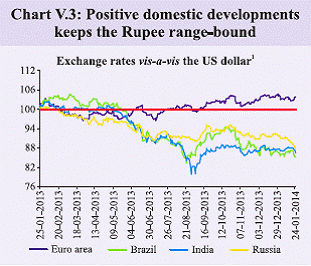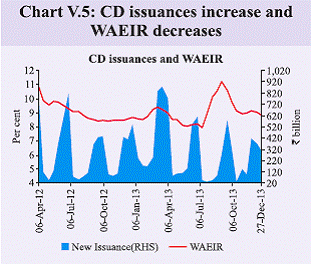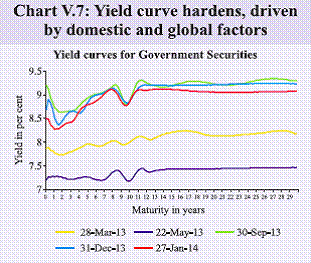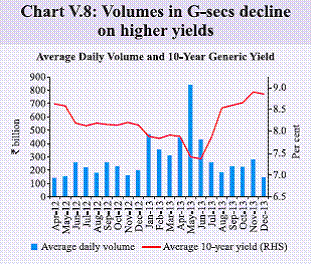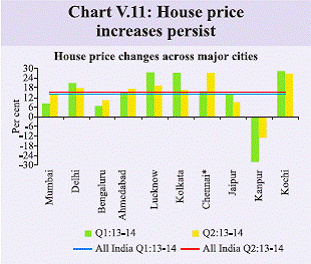V. Financial Markets - ଆରବିଆଇ - Reserve Bank of India
V. Financial Markets
The Fed tapering announcement on December 18, 2013 did not exert significant pressures on equity and bond markets across the globe. Unlike the May 22 situation when the tapering announcement unnerved markets, this time around, Indian markets withstood the announcement better than other emerging market peers, having utilised the interim period to re-build buffers. Encouraging news on the trade front along with return of capital flows appears to have abated the pressures on the Indian rupee. However, going forward, markets will be conditioned by political outcomes and the commitment to reforms. Global financial markets improve; withstand the tapering decision V.1 10-year US bond yields, which stood at 2.85 per cent on the eve of the FOMC meet on December 17, 2013 rose to above 3 per cent on December 31, 2013 following the Fed announcement on December 18 that it will lower the monthly pace of asset purchases by US $ 10 billion to US $ 75 billion starting in January 2014. The reduction is split equally between Treasuries (from US$ 45 billion to US$ 40 billion) and mortgage-backed securities (from US$ 40 billion to US$ 35 billion). V.2 Reactions to the actual tapering decision were far more muted than those at the mere indication of a tapering possibility in May 2013. At that point, there were several disruptions that the event caused. First, the US generic 10-year bond yield rose by 46 bps in May and crossed 2 per cent, prompting a bond sell-off across the globe as financial markets priced in the global interest rate cycle turning earlier-than-anticipated. Second, capital outflows began from emerging economies bond markets, prompting their exchange rates to weaken, which in turn motivated equity sell-offs. This further exacerbated exchange rate pressures through a self-perpetuating cycle that rapidly deteriorated financial conditions across emerging markets. Thirdly, there were macroeconomic costs in terms of resurgence of inflation in EMDEs fuelled by pass-through from exchange rate depreciation. Fourth, capital flow reversals and tightening financial conditions along with domestic risks had adverse effects on economic growth in these countries. India was amongst the countries that faced these headwinds, even though subsequent policy actions helped mitigate the effects. V.3 The postponement of tapering by a few months enabled global financial markets to return to more orderly conditions. Equity indices such as S&P 500 and the Dow Jones reached all-time highs following the positive news on employment, economic growth, confirmation by the US Senate of Janet Yellen as the Fed chair, and a two-year budget agreement that eased automatic spending cuts and reduced the risk of a government shutdown (Chart V.1). On the other side of the Atlantic, the ECB kept its policy rate unchanged in its meeting on January 9, 2014. Coupled with the progress towards a European Banking Union, these developments provided support to equity and bond markets. V.4 The Fed tapering moves over the course of 2014 will be closely watched by central banks in EMDEs. The Fed’s decision to delay tapering in September had stabilised EMDE capital markets and eased capital outflows considerably, providing breathing space to several countries to address domestic risks. Certain countries with large CADs that came under pressure in the summer continued to tighten their monetary policies post-September in efforts to calm investors, whereas India scaled back exceptional tightening measures amidst the revival of capital flows and a decline in CAD. As compared to tremors across financial markets after the May 22 announcement, this time around, the Fed statement had limited impact on EMDE equity and bond markets (Chart V.2). In addition to the continuing tapering concerns, EMDEs have come under considerable pressure in the latter part of January 2014 amid slowing growth in China, political risks in Thailand and Ukraine and a sudden currency depreciation in Argentina. Rupee remains range-bound in Q3 of 2013-14 V.5 As already stated, when the Fed first announced its taper intention in May 2013, the rupee depreciated sharply, hitting a historic low in end-August. However, unlike that time, the impact of the actual tapering decision on December 18 on the rupee was not significant. In fact, Q3 of 2013-14 was marked by low exchange rate volatility with a small appreciation of 0.3 per cent (based on average exchange rate of Q3 over Q2). In contrast, in Q1 and Q2 the exchange rate was volatile and the rupee depreciated by 3.2 per cent and 10.1 per cent, respectively (Chart V.3). Exchange rate stability was to a considerable extent driven by introduction of a forex swap window for the public sector oil marketing companies, postponement of tapering by the Fed and a lower CAD during Q2 of 2013-14. Besides, confidence was instilled by forex buffers built by FCNR(B)/ banks’ overseas foreign currency borrowings (see also Chapter III). Money market rates soften upon normalisation of exceptional monetary policy measures V.6 Rates in the money market were rangebound during the early part of July 2013. However, as the rupee depreciated sharply, the Reserve Bank responded with a series of policy measures during July-August to tighten liquidity and contain exchange rate volatility (see also Chapter IV). The net effect of these measures led to a significant rise in money market rates across the spectrum. As markets gradually returned to normalcy, the Reserve Bank effected a calibrated unwinding of its exceptional measures. As a result, money market rates gradually softened during Q3 of 2013-14 across the spectrum. Having utilised the interim period to build buffers, when the actual path of tapering was announced in December 2013, the markets were not unduly concerned. From a high of 9.97 per cent in September 2013, weighted average call rates declined to 8.16 per cent in December 2013 (Chart V.4). A similar magnitude of decline was witnessed in the CBLO rate as well. Money market rates have witnessed some hardening since the second half of December, on the back of tighter liquidity conditions emanating from advance tax outflows. After initial softening, money market rates remained elevated during January 2014 so far, reflecting tight liquidity conditions arising out of elevated government balances with the Reserve Bank and rise in currency in circulation. Increase in CD issuance V.7 The tightening in money market rates impacted CD issuances, with the weighted average effective interest rate (WAEIR) peaking to 11.2 per cent in the early part of September 2013. As markets returned to normalcy and liquidity conditions improved, rates declined whereas volumes increased (Chart V.5). Gradual improvement in CP issuance V.8 As in the case with CDs, in response to the exceptional measures by the Reserve Bank, issuance of CPs by firms hit a two-year low, in July 2013. The weighted average discount rate (WADR) also touched a high of 11.9 per cent at end-August 2013. As the calibrated unwinding took hold, the volume of issuances picked up and rates declined (Chart V.6). Accordingly, the outstanding amount of CPs also increased. G-sec yields remained firm in Q3 of 2013-14 V.9 The effect of the announcement on May 22, 2013 and the subsequent measures by the Reserve Bank firmed up government yields to a significant extent. As markets stabilised, the Reserve Bank announced a cautious unwinding of its earlier measures. More specifically, taking cues from the OMO purchase auction and a 50 bps reduction in the MSF rate on October 7, 2013, G-sec yields softened. However, the yields hardened during November 2013 led by a hike in the repo rate by 25 bps on October 29, 2013, better than expected US non-farm payroll numbers and higher domestic inflation numbers for October 2013. The G-sec yields softened to some extent towards the end of the month on OMO auction announcement and introduction of new benchmark security. V.10 Yields hardened again in December 2013 on higher domestic inflation numbers for November 2013 and the US Fed tapering announcement, despite getting some support after the policy rate was left unchanged in the mid-quarter review on December 18, 2013. Thus, during Q3 of 2013-14, G-sec yields remained firm. However, in the start of Q4 of 2013-14, the yields have softened on better inflation numbers for December 2013 and on announcement of OMO purchase auction and 28-day term repo auction (Chart V.7). V.11 The average daily trading volume of central government securities has remained low during Q3 of 2013-14 (Chart V.8). V.12 During the year thus far, the government has completed 93 per cent of its overall borrowings (96 per cent on a net basis) for the year (Table V.1). The government availed WMAs on ten occasions and availed overdraft on three occasions during this period. Inflation indexed bonds launched V.13 The Reserve Bank of India, in consultation with the Government of India (GoI) launched Inflation Indexed Bonds (IIBs) for institutional investors, with inflation protection to both principal and coupon, on June 4, 2013. IIBs have been issued seven times during 2013-14 so far, with an outstanding amount of `65 billion. V.14 Subsequently, a special series of IIBs for retail investors (such as individuals, trusts and universities), namely Inflation Indexed National Saving Securities-Cumulative (IINSS-C), was launched on December 23, 2013. The inflation compensation in this product has been linked to the combined consumer price index [CPI base: 2010=100] and the interest rate comprises of two parts: a fixed rate of 1.5 per cent per annum plus an inflation rate based on CPI, with a lag of three months. The initial response to the new product has been somewhat limited with a subscription of `603 million till January 25, 2014. As retail investors need more time to understand the product, the last date for application to the scheme has been extended to March 31, 2014. Equity market stages a recovery V.15 After initial gains during the early part of the year, the Fed taper announcement had disrupted global stock markets. During May 22 - August 30, the Sensex and Nifty declined as FIIs withdrew US$ 13 billion from domestic debt and equity markets. As normalcy returned, the stock market also recovered. The BSE Sensex and Nifty both increased by over 9 per cent during the third quarter as compared to a decline in both these indices during the previous quarter (Chart V.9). Buoyed by the demonstrated resilience after the December 18 Fed announcement, key stock market indices rallied on account of buying by FIIs. However, in line with global sell-offs, Indian equity market witnessed selling pressure in January 2014 thus far. FII investments in equity witness a revival V.16 As confidence returned to the markets, FII investments also witnessed a revival (Chart V.10). Earlier, FIIs were net sellers in the debt segment. In December 2013, FIIs turned net investors in the debt segment as well. Mutual funds, however, continued to remain net sellers in the equity segment, but net buyers in the debt segment. Primary equity market continues to remain lacklustre V.17 Low earnings growth in the corporate sector and slowdown in investment demand weighed adversely on the primary equity market. The total amount raised through public and rights issues was about 90 per cent of the amount raised during the corresponding period of the previous year (Table V.2). Twenty four of the 25 IPOs during 2013-14 so far were by SMEs who mobilised `2.5 billion. Resource mobilisation by mutual funds also remained low. Price pressures persist in housing V.18 House price pressures, that abated in Q1 of 2013-14 have shown some signs of increase in Q2. The y-o-y increase in the Reserve Bank House Price Index (Base year = 2010-11) at the all-India level was 15.0 per cent in Q2 of 2013-14 as compared to 13.8 per cent in the preceding quarter (Chart V.11). Indian financial markets better placed as global investor sentiments improve, but uncertainties remain V.19 The government and the Reserve Bank acted proactively in the recent period to ensure better macroeconomic management and reduce financial volatilities. This has helped in improving global investor sentiments and several investment houses turned overweight on India in November-December 2013, even while being underweight on emerging markets for their portfolio allocation calls for 2014. Nonetheless, with domestic demand remaining sluggish and investment activity hesitant, the economy does not appear to be out of the woods, yet. While recessionary headwinds are feeding into corporates’ and banks’ balance sheets, there are some signs that slippages are starting to come off. By now, markets appear to have priced-in much of the upside and the tipping point could come around the forthcoming general elections. If political risks are wellmanaged and a renewed political commitment to reforms is seen to be in place, both financial markets and the real sector could gain. In the interim, a closer and continuous monitoring of potential risks and pre-emptive policy action appears to be the need of the hour. 1US dollars per unit of local currency. An increase indicates appreciation of the local currency *Based on both residential and commercial properties. |













